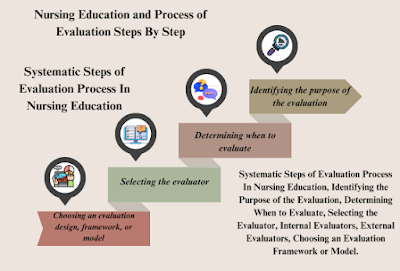The Process of Evaluation Process in Nursing Education. Learning assessment is the process of evaluating the effectiveness of educational programs, courses, or training initiatives. It goes beyond simple completion rates and examines how well students have understood and applied the knowledge taught.
The Process of Evaluation Process in Nursing Education
The assessment process in nursing education is a systematic method for evaluating the effectiveness of teaching and learning. It includes data collection and analysis, interpretation of results, and evaluation of student progress and program effectiveness. This process helps identify potential for improvement in teaching and learning.
The “Assessment” standard is defined as follows: “The registered nurse assesses progress toward achieving goals and outcomes.” During assessment, nurses evaluate the patient and compare the results with the initial assessment to determine the effectiveness of interventions and the overall care plan.
The nursing process serves as a systematic guide for patient-centered care with five sequential steps: assessment, diagnosis, planning, implementation, and evaluation. Assessment is the first step and involves critical thinking and the collection of subjective and objective data.
The evaluation process in nursing education follows a systematic series of actions that ensure a thorough and organized approach. These steps include:
- Identifying the Purpose of the Evaluation
- Determining When to Evaluate
- Selecting the Evaluator
- Choosing an Evaluation Design, Framework, or Model
- Selecting an Evaluation Instrument
- Collecting Data
- Interpreting Data
- Reporting the Findings
- Using the Findings
- Considering the Costs of Evaluation
These steps can be adjusted depending on the evaluation’s purpose, whether it’s for students, instruction, a program, or a system, and the complexity of the components being evaluated.
1. Identifying the Purpose of the Evaluation
Similar to research, the first step in the evaluation process is defining questions that can be addressed through evaluation. These questions can range from broad topics like program evaluation to specific, focused inquiries such as classroom assessment.
2. Determining When to Evaluate
The timing of the evaluation is crucial. Evaluators must decide the most appropriate moment for conducting evaluations. Formative and summative evaluations both play key roles, providing their respective strengths to the evaluation plan. The evaluator should also determine how often evaluations should be conducted.
While evaluations can be time-consuming, they are necessary in many situations, especially when the learning process is complex, unfamiliar, or when there is a high risk of failure.
3. Selecting the Evaluator
Choosing an evaluator is an important element in the evaluation process. The evaluator can be selected from within the organization (internal evaluator) or from outside (external evaluator), depending on the needs of the evaluation.
Internal Evaluators
Internal evaluators are those directly involved in the learning, course, or program to be evaluated, such as students, faculty, or nursing staff.
- Advantages: Internal evaluators are familiar with the context, are experienced with the standards, offer cost-effective solutions, and can provide quicker feedback.
- Disadvantages: Potential bias, control over the evaluation process, and reluctance to share controversial findings.
External Evaluators
External evaluators, who are often consultants or represent accrediting bodies, are not directly involved in the events being evaluated.
- Advantages: External evaluators bring objectivity, lack of bias, expertise, and are uninvolved in organizational politics.
- Disadvantages: They may be expensive, unfamiliar with the context, and face time or travel constraints.
4. Choosing an Evaluation Framework or Model
An evaluation model serves as the framework for organizing variables, items, or events to be evaluated. It helps clarify relationships between the variables and provides a systematic plan for the evaluation.
Models offer several advantages, such as making variables explicit, providing visible structure, and focusing evaluation efforts. A model can be selected based on the evaluation question, context, and the stakeholders’ needs.
Common Models in Nursing Education:
- Chen’s Theory-Driven Model (2004): Directs variables to be measured.
- Stufflebeam’s CIPP Model (1971): Organizes variables into context, input, process, and product categories.
- Lincoln and Guba’s Naturalistic Models (1985): Involve stakeholders to determine consensus about necessary changes.
- Kirkpatrick’s Four-Level Evaluation Model (2014): Evaluates reaction, learning, behavior, and outcomes.
- Rogers’s Model of Adoption of Innovations (2003): Explains how innovations are diffused through an organization, highlighting early adopters and laggards.
- Quality Matters (2014): Provides benchmarks and rubrics for evaluating online courses.
By selecting a model appropriate for the situation, educators can ensure that their evaluation process is organized, focused, and geared toward obtaining actionable insights.
Read More:
https://nurseseducator.com/didactic-and-dialectic-teaching-rationale-for-team-based-learning/
https://nurseseducator.com/high-fidelity-simulation-use-in-nursing-education/
First NCLEX Exam Center In Pakistan From Lahore (Mall of Lahore) to the Global Nursing
Categories of Journals: W, X, Y and Z Category Journal In Nursing Education
AI in Healthcare Content Creation: A Double-Edged Sword and Scary
Social Links:
https://www.facebook.com/nurseseducator/
https://www.instagram.com/nurseseducator/
https://www.pinterest.com/NursesEducator/
https://www.linkedin.com/in/nurseseducator/
https://www.researchgate.net/profile/Afza-Lal-Din
https://scholar.google.com/citations?hl=en&user=F0XY9vQAAAAJ
